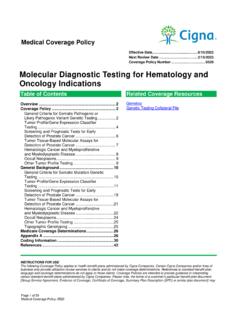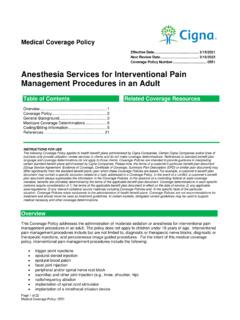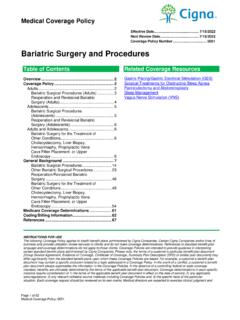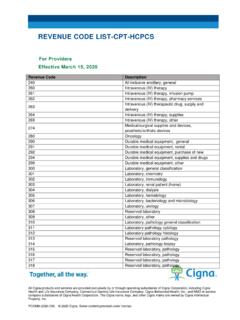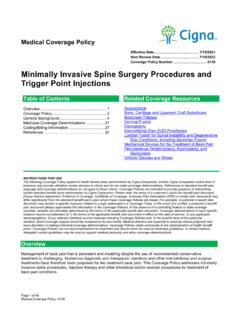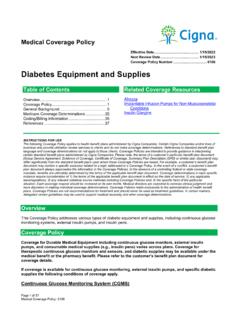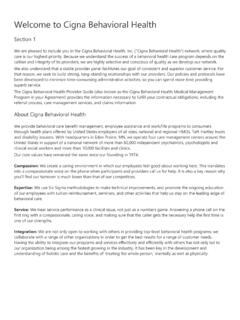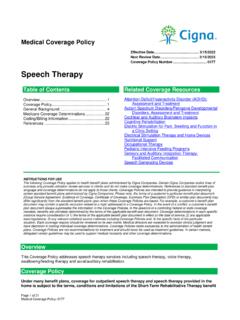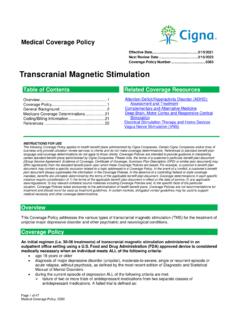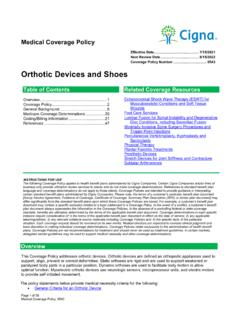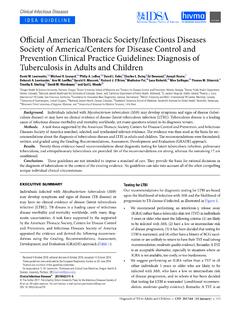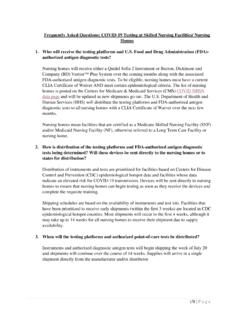Transcription of Nucleic Acid Pathogen Testing - Cigna
1 Medical Coverage Policy Effective Date .. 9/15/2021. Next Review 1/15/2022. Coverage Policy Number .. 0530. Nucleic acid Pathogen Testing Table of Contents Related Coverage Resources Overview .. 1 Preventive Care Services Coverage General Background ..3. Medicare Coverage Determinations ..8. Coding/Billing Information ..9. References ..36. INSTRUCTIONS FOR USE. The following Coverage Policy applies to health benefit plans administered by Cigna Companies. Certain Cigna Companies and/or lines of business only provide utilization review services to clients and do not make coverage determinations. References to standard benefit plan language and coverage determinations do not apply to those clients. Coverage Policies are intended to provide guidance in interpreting certain standard benefit plans administered by Cigna Companies. Please note, the terms of a customer's particular benefit plan document [Group Service Agreement, Evidence of Coverage, Certificate of Coverage, Summary Plan Description (SPD) or similar plan document] may differ significantly from the standard benefit plans upon which these Coverage Policies are based.
2 For example, a customer's benefit plan document may contain a specific exclusion related to a topic addressed in a Coverage Policy. In the event of a conflict, a customer's benefit plan document always supersedes the information in the Coverage Policies. In the absence of a controlling federal or state coverage mandate, benefits are ultimately determined by the terms of the applicable benefit plan document. Coverage determinations in each specific instance require consideration of 1) the terms of the applicable benefit plan document in effect on the date of service; 2) any applicable laws/regulations; 3) any relevant collateral source materials including Coverage Policies and; 4) the specific facts of the particular situation. Each coverage request should be reviewed on its own merits. Medical directors are expected to exercise clinical judgment and have discretion in making individual coverage determinations. Coverage Policies relate exclusively to the administration of health benefit plans.
3 Coverage Policies are not recommendations for treatment and should never be used as treatment guidelines. In certain markets, delegated vendor guidelines may be used to support medical necessity and other coverage determinations. Overview This Coverage Policy (CP) addresses Nucleic acid infectious Pathogen Testing . infectious Pathogen Testing using Nucleic acid laboratory methods identifies the deoxyribonucleic acid (DNA) and ribonucleic acid (RNA) of disease -causing microorganisms, including viruses, bacteria and fungi, including yeast, for the purpose of diagnosis and treatment. The scope of this Coverage Policy (CP) includes medically appropriate indications for Nucleic acid infectious Pathogen Testing for selected pathogens , including Testing of single or multiple Pathogen targets. Indications addressed within the scope of this CP include Testing for chlamydia, candida, gardnerella vaginalis, gonorrhea, genital herpes (herpes simplex virus [HSV], type 1 and 2), high-risk human papillomavirus (HPV), onychomycosis, nail dystrophy, syphilis, tineas, trichomonas, respiratory, gastrointestinal and central nervous system Pathogen panels, Nucleic acid Testing to identify pathogens related to urinary tract infection and Nucleic Page 1 of 37.
4 Medical Coverage Policy: 0530. acid quantification. Please refer to CP 0557 COVID-19: In Vitro Diagnostic Testing for information regarding single Pathogen Nucleic acid Testing for SARS-CoV-2 (COVID-19). Coverage Policy Medically Necessary Nucleic acid Pathogen Testing (see CPT code list below) is considered medically necessary for EITHER. of the following: Asymptomatic individuals with any of the following: o high-risk behavior ( , exposure to possible infected partner). o high-risk condition ( , pregnancy, HIV infection). o high-risk experience ( , assault). o chlamydia screening in sexually active individual o gonorrhea screening in sexually active individual o human papillomavirus (HPV) cervical cancer screening Symptomatic individuals when the associated signs and symptoms or diagnoses, are listed in the coding/billing information section: Pathogen CPT Codes Candida 87480, 87481, 87482. Chlamydia (Chlamydia trachomatis) 87490, 87491, 87492. Gardnerella vaginalis 87510, 87511, 87512.
5 Herpes Simplex Virus (HSV) Types 1 and 2 87528, 87529, 87530. Gonorrhea (Neisseria gonorrhea) 87590, 87591, 87592. Human Papillomavirus (HPV), high-risk 87624. types ( , types 16, 18, 31, 33, 35, 39, 45, 51, 52, 56, 58, 59, 68). Trichomoniasis (Trichomonas vaginalis) 87660, 87661. infectious Pathogen detection by Nucleic acid panel is considered medically necessary for the following: respiratory pathogens ( , up to 5 targets). gastrointestinal pathogens ( , up to 5 targets). central nervous system pathogens ( , 12-25 targets). Not Medically Necessary Nucleic acid Pathogen Testing of single Pathogen or by panel is considered not medically necessary if the criteria described above are not met. Nucleic acid Pathogen Testing is considered not medically necessary for the diagnosis of ANY of the following indications: human papilloma virus (HPV), low-risk types ( , types 6, 11, 42, 43, 44). syphilis nail dystrophy onychomycosis tinea infections of the urinary tract ( , pyelonephritis, cystitis, prostatitis).
6 Page 2 of 37. Medical Coverage Policy: 0530. Nucleic acid quantification to monitor for disease progression or therapy outcomes is considered not medically necessary for the following pathogens : Gardnerella vaginalis non-invasive Candida Neisseria gonorrhea herpes simplex virus (HSV) Types 1 & 2. Not Reimbursable Use of Not Otherwise Specified (NOS) CPT codes: 87797, 87798, 87799 for molecular microbe Testing is not reimbursable when a more specific CPT/HCPCS code is available for use. General Background The purpose of infectious Pathogen Testing using Nucleic acid laboratory methods is to identify the deoxyribonucleic acid (DNA) and ribonucleic acid (RNA) of disease -causing microorganisms, including viruses, bacteria and fungi, including yeast, for the purpose of diagnosis and treatment. Nucleic acid Pathogen Testing provides sensitive, specific and timely identification of microorganisms. A Nucleic acid test analyzes tiny amounts of DNA or RNA in a sample of blood, tissue or body fluid.
7 Because the amount of genetic material is very small the test may include a step where the DNA or RNA of the microorganism is amplified, or increased. This type of Nucleic acid Pathogen test is known as a Nucleic acid amplification test or NAAT. The NAAT format increases diagnostic sensitivity by decreasing the lower limit of detection. For some pathogens there may be a need to determine the precise concentration of DNA or RNA. present, rather than only detecting the presence of the microorganism. This is referred to as Nucleic acid quantification. Nucleic acid Pathogen Testing for chlamydia trachomatis (chlamydia), gardnerella vaginalis, Neisseria gonorrhea (gonorrhea), genital herpes (herpes simplex virus [HSV] type 1 and 2), human papillomavirus (HPV), candida, syphilis and trichomoniasis (trichomonas vaginitis) may be appropriate for asymptomatic individuals with high- risk behavior ( , exposure to possible infected partner, high-risk conditions ( , pregnancy, HIV infection), or high-risk experiences ( , assault) or when otherwise required under the prevention provisions of the Affordable Care Act.)
8 Nucleic acid infectious Pathogen Testing may also be appropriate for a symptomatic individual when the associated signs and symptoms or diagnoses, are listed in the coding/billing information section of this Coverage Policy. Standard laboratory methods, such as microscopy, gram stain, culture, histology, or antibody or antigen tests are considered the gold standard to detect the presence of some microorganisms, such as gardnerella vaginalis, mucosal and noninvasive candida and syphilis. Appropriate use of Nucleic acid infectious Pathogen Testing is informed by authoritative statements from the infectious Diseases Society of America (IDSA), Centers for disease Control and Prevention (CDC), American Cancer Society, Association of Public Health Laboratories, Preventive Services Task Force and the Center for Medicare and Medicaid Services, published, professional society recommendations and other published sources. Candida There are over 20 species of Candida yeasts that can cause infection in humans.
9 Candida yeasts normally reside in the intestinal tract and can be found on mucous membranes, skin and nails, without causing infection;. however, overgrowth of these organisms can cause symptoms to develop. Symptoms of candidiasis vary depending on the area of the body that is infected. Esophageal candidiasis is one of the most common infections in people living with HIV/AIDS. Invasive candidiasis occurs when Candida species enter the bloodstream and spread throughout the body. Unlike Page 3 of 37. Medical Coverage Policy: 0530. Candida infections in the mucosa of the mouth and throat (also called thrush ) or vaginal yeast infections, invasive candidiasis is a serious infection that can affect the blood, heart, brain, eyes, bones, and other parts of the body. Candidemia, a bloodstream infection with candida, is a common cause of infection and sepsis in hospitalized patients. Symptoms can develop if the infection spreads to other parts of the body, such as the heart, which may result in endocarditis, brain (meningitis), lungs and esophagus (CDC, 2018).
10 Standard laboratory tests for the diagnosis of the skin, soft tissue, nails and mucosal tissues are fungal culture, calcofluor-KOH preparation stain, blood culture and histopathology (IDSA, 2018). Increasingly, Nucleic acid Testing is being used to establish a diagnosis of invasive candida ( , candidemia) and candidiasis ( , vaginal yeast infection). The role of Nucleic acid Pathogen Testing to identify candida as a causative Pathogen in the diagnosis of onychomycosis or nail dystrophy has not been established. Chlamydia (Chlamydia Trachomatis). Chlamydial infection is the most frequently reported infectious disease in the United States (IDSA, 2018; CDC, 2015). Individuals with chlamydia may be asymptomatic or symptomatic. If symptomatic, presenting symptoms include cystitis with or without hematuria, urethritis, acute vulvo-vaginitis, lower urogenital tract infection, pelvic inflammatory disease , acute prostatitis, proctitis, epididymitis, orchitis, cervicitis, endometritis, genital lesions, dysuria and urethral discharge.
